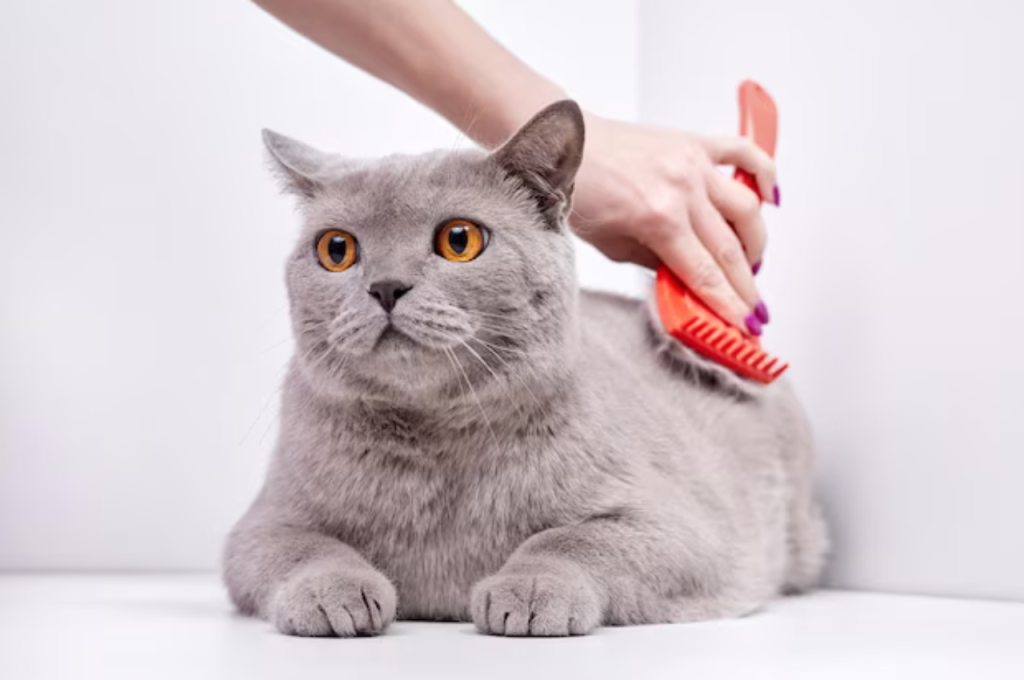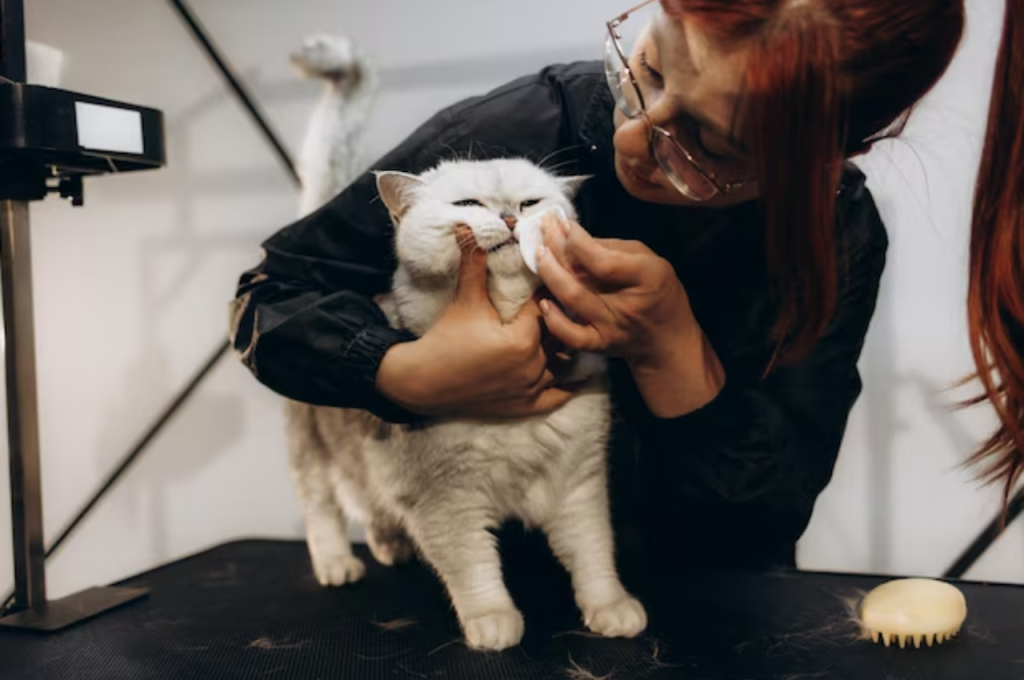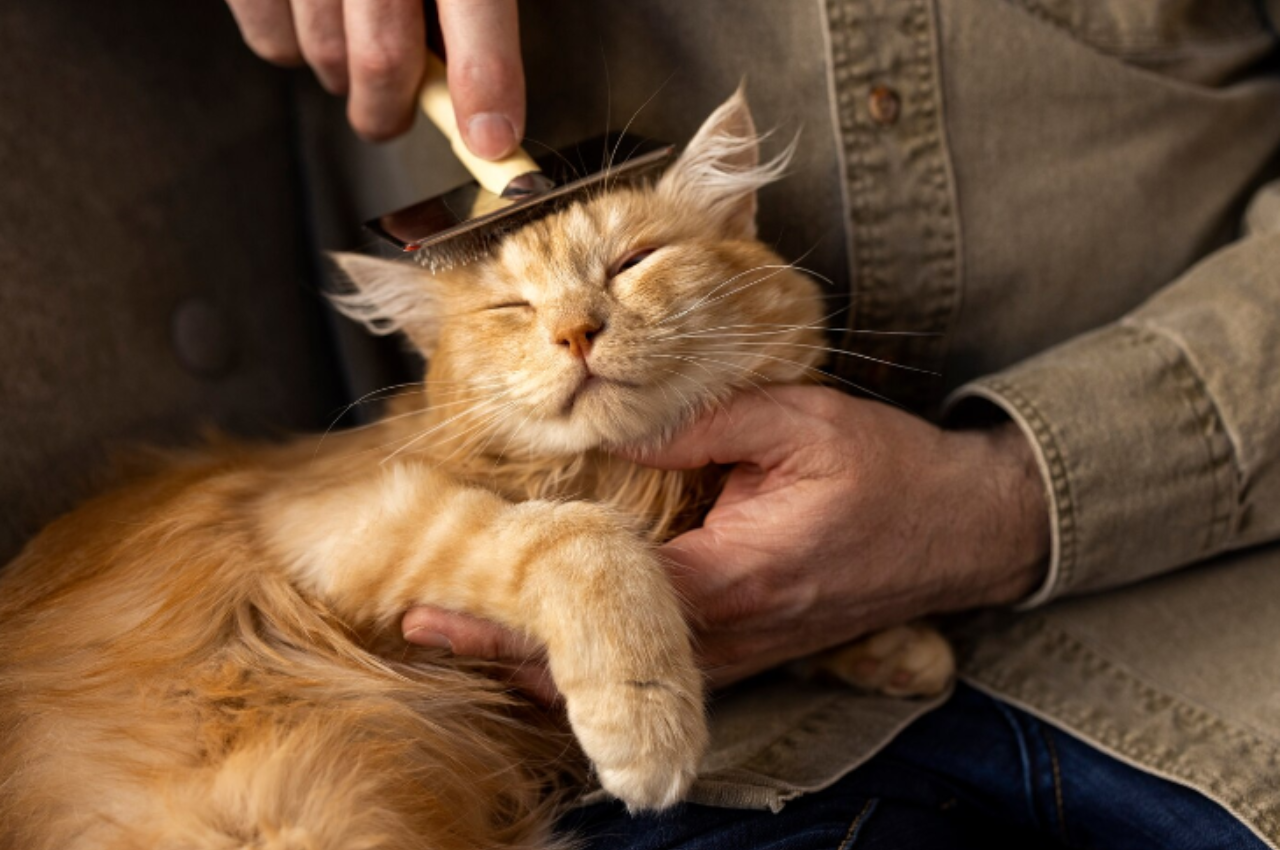To groom a cat, brush its fur regularly and gently using a cat-specific brush, paying attention to any tangles or mats. Regular brushing not only keeps the coat smooth and shiny but also helps reduce shedding and hairballs. For long-haired cats, daily brushing is ideal, while short-haired cats can be groomed a few times a week. During grooming, check for any signs of fleas, ticks, or skin issues.
In addition to brushing, regularly clean your cat’s ears with a vet-recommended solution and trim their nails to prevent overgrowth and damage to furniture. Bathing isn’t usually necessary unless your cat gets particularly dirty, but if needed, use a cat-safe shampoo. Always handle your cat with care and ensure the grooming process is a positive experience.
Introduction to Cat Grooming
Grooming your cat is an essential part of maintaining their health and well-being. Regular grooming not only keeps your feline friend looking their best, but it also plays a crucial role in preventing health issues and strengthening the bond between you and your pet.

Benefits for Your Feline Friend
Cat grooming offers several benefits, including:
- Preventing matting and tangling of fur
- Reducing shedding and hairballs
- Monitoring your cat’s skin and coat for any abnormalities
- Promoting healthy circulation and skin
- Strengthening the bond between you and your cat
Frequency of Grooming Sessions
The frequency of grooming sessions depends on your cat’s breed, coat length, and lifestyle. Generally, short-haired cats may require grooming once a week, while long-haired breeds may need grooming every day to prevent matting and tangles.
Essential Grooming Tools
Grooming your cat regularly is essential for maintaining their health and well-being. Using the right tools is crucial for effective grooming. Here are the essential grooming tools you’ll need:
Brushes and Combs
Brushes and combs are essential for keeping your cat’s coat in top condition. A slicker brush is ideal for removing loose fur and preventing matting. For long-haired cats, a wide-toothed comb can help detangle and prevent knots. Rubber brushes are great for removing loose hair and massaging the skin, while a flea comb can help detect and remove any unwanted pests.
Nail Clippers
Nail clippers are necessary for keeping your cat’s claws at a healthy length. Opt for small, scissor-style clippers that are specifically designed for cats. Regular trimming can prevent ingrown nails and minimize scratching damage.
Shampoo Choices
When choosing a shampoo for your cat, opt for a mild, unscented formula designed specifically for felines. Look for natural ingredients such as oatmeal or aloe vera to ensure it’s gentle on your cat’s skin. Avoid using human shampoos as they can be too harsh for their sensitive skin.
Starting with Brushing
Starting with brushing is a key step in learning how to groom a cat effectively. Regular brushing helps remove loose fur, reduces shedding, and prevents mats from forming, especially in long-haired cats. Begin with a gentle, cat-specific brush, working slowly and carefully to ensure your cat feels comfortable. Start by brushing in the direction of the fur’s growth, paying special attention to areas prone to tangling, like under the legs and around the neck.
Brushing not only keeps your cat’s coat healthy and shiny but also provides a bonding experience that strengthens your relationship with your pet. Regular grooming sessions can also help you spot any skin issues or parasites early on, ensuring your cat remains healthy and happy.
Techniques for Long-haired vs Short-haired Cats
Long-haired cats require more frequent and thorough brushing compared to short-haired cats. Use a wide-toothed comb for long-haired cats and a soft-bristle brush for short-haired cats.
Tips to Avoid Matting
To prevent matting, brush your cat’s fur regularly, especially in areas prone to tangling such as behind the ears and under the legs. Use a detangling spray for long-haired cats.
Bathing Your Cat
Bathing your cat can be a challenge, but it’s sometimes necessary, especially if your cat has gotten into something sticky or smelly. To groom a cat properly during bath time, start by filling the tub with a few inches of lukewarm water. Gently place your cat in the tub, using a calm voice to keep them relaxed. Use a cat-specific shampoo, lathering it thoroughly but avoiding the face and ears. Rinse completely to remove all soap residues, as any leftover can irritate your cat’s skin.
After the bath, wrap your cat in a warm towel and gently dry them off. If your cat tolerates it, use a hairdryer on a low setting to help speed up the drying process. Regular grooming, including occasional baths, can help maintain your cat’s coat and skin health.
Pre-bath Preparation
- Calmly approach cat with gentle movements to reduce stress.
- Prepare warm water, cat shampoo, towel, and a non-slip mat.
- Brush your cat’s fur to remove any tangles or mats.
Step-by-step Bathing Process
- Gently place cat in the water, starting with the back.
- Use a cup to pour water over the cat, avoiding the face.
- Apply cat shampoo, lather, and rinse thoroughly.
- Wrap cat in a towel and gently pat dry.
Nail Trimming Essentials
Cat grooming includes essential nail trimming to maintain their health and prevent scratching. Use proper tools and techniques to ensure a stress-free experience for your feline friend. Regular grooming helps avoid issues like ingrown nails and keeps your cat comfortable and happy.
Nail Trimming Essentials Grooming your cat is an important aspect of pet ownership, and one task that can often be overlooked is trimming your cat’s nails. It’s essential to keep your cat’s nails trimmed to prevent them from getting too long and causing discomfort or even injury to your furry friend. In this section, we’ll cover the nail trimming essentials, including getting your cat comfortable, safe nail clipping techniques, and more.
Getting Your Cat Comfortable
Before you start trimming your cat’s nails, it’s crucial to make sure they’re comfortable and relaxed. You can do this by petting and talking to your cat, offering treats or toys, or even giving them a massage. It’s also essential to choose a quiet, well-lit area to trim your cat’s nails, where they feel safe and secure.

Safe Nail Clipping Techniques
When it comes to clipping your cat’s nails, it’s important to use safe and proper techniques to avoid injuring your pet. Start by holding your cat’s paw firmly but gently, and use a pair of sharp, high-quality nail clippers designed specifically for cats. It’s essential to avoid cutting too close to the quick, which is the pink part of the nail that contains blood vessels and nerves. If you accidentally cut the quick, it can be painful and may cause bleeding.
Final Tips for Nail Trimming
In addition to the above tips, here are some final tips to make nail trimming a success:
- Trim your cat’s nails regularly, at least once every two weeks.
- If your cat is particularly nervous or resistant to nail trimming, consider getting help from a professional groomer or veterinarian.
- Offer treats or rewards after each successful nail trimming session to help your cat associate the experience with positive feelings.
- Be patient and take breaks if needed to avoid stressing out your cat.
By following these nail trimming essentials, you’ll be able to keep your cat’s nails healthy and prevent any potential discomfort or injury. Remember to always prioritize your cat’s comfort and safety, and don’t hesitate to seek professional help if needed.
Ear and Eye Care
When it comes to grooming your cat, proper ear and eye care are essential for maintaining their overall health and well-being.
Routine Ear Cleaning
Regularly cleaning your cat’s ears helps prevent infections and buildup of wax.
- Gently wipe the outer ear with a damp cotton ball.
- Avoid using Q-tips as they can damage the ear canal.
- If you notice redness, swelling, or a foul odor, consult your vet.
Keeping The Eyes Clean
Keeping your cat’s eyes clean helps prevent irritation and infections.
- Use a soft, damp cloth to wipe away any discharge or dirt.
- Check for any redness, cloudiness, or excessive tearing.
- If you notice any issues, seek advice from your veterinarian.
Dental Hygiene for Cats
Maintaining dental hygiene in cats is essential to prevent dental issues. Groom your cat regularly by brushing its teeth with feline toothpaste, offering dental treats, and providing chew toys. This routine helps to reduce plaque and tartar buildup, ensuring your cat’s overall dental health.
When it comes to grooming cats, dental hygiene should not be overlooked. Just like humans, cats also need proper dental care to prevent dental problems such as tartar buildup, gingivitis, and periodontal disease. In this section, we will discuss how to maintain your cat’s dental hygiene, including choosing the right toothbrush and toothpaste, and brushing your cat’s teeth.
Choosing The Right Toothbrush and Toothpaste
Choosing the right toothbrush and toothpaste is essential for your cat’s dental care. You need to select a toothbrush that is specifically designed for cats. The bristles should be soft and gentle to avoid damaging the cat’s teeth and gums. You can also use a finger brush, which is a soft rubber brush that fits over your finger. Finger brushes are often easier to use, especially if your cat is not used to having its teeth brushed.
When it comes to toothpaste, you should never use human toothpaste on cats. Human toothpaste contains ingredients that are harmful to cats, such as fluoride. Instead, use toothpaste that is specifically designed for cats. These toothpaste flavors are more appealing to cats, making the brushing experience less stressful for them.
Brushing Your Cat’s Teeth
Brushing your cat’s teeth may seem like a daunting task, but with patience and practice, it can become a part of your cat’s grooming routine. Here are some steps to follow:
- Introduce your cat to the toothbrush and toothpaste. Let your cat sniff and taste the toothpaste to get used to the flavor.
- Gently hold your cat’s head and lift its lip to expose the teeth.
- Use the toothbrush or finger brush to brush your cat’s teeth gently. Start with the front teeth and work your way back.
- Be sure to brush both the inside and outside of the teeth and gums.
- Reward your cat with a treat or praise after each brushing session.
In conclusion, dental hygiene is an essential part of your cat’s overall health. By following the tips mentioned above, you can help maintain your cat’s dental hygiene and prevent dental problems. Remember to be patient and gentle when brushing your cat’s teeth, and always use toothbrushes and toothpaste specifically designed for cats.
Dealing with Common Grooming Challenges
Address common grooming challenges when grooming a cat, such as matting, shedding, and nail trimming. Use a gentle brush to remove mats and tangles, and a shedding tool to reduce shedding. Trim the cat’s nails regularly to prevent them from becoming too long and causing discomfort.
Grooming your cat is an essential part of their health and wellbeing. However, it can be challenging to groom cats, especially when they are fussy or senior. In this article, we will discuss how to deal with common grooming challenges, including handling a fussy cat and grooming tips for senior cats.
Handling a Fussy Cat
Cats are known for their independent nature, which can make grooming a challenge. If your cat is fussy, it’s essential to approach grooming with patience and a gentle touch. Here are some tips to help you groom a fussy cat:
- Start Slow: Begin by petting your cat to help them relax before you start grooming. Use a soft-bristled brush and start grooming from the head to the tail, using short strokes.
- Use Treats: Reward your cat with treats throughout the grooming process to keep them calm and focused. Use treats that your cat loves and offer them after completing each grooming task.
- Take Breaks: If your cat becomes too fussy, take a break and try again later. Never force your cat to continue grooming if they are not comfortable.
Grooming Tips for Senior Cats
As cats age, they may require special grooming care to maintain their health and comfort. Here are some grooming tips for senior cats:
- Brushing: Senior cats may have difficulty grooming themselves, so regular brushing is essential to prevent matting and hairballs.
- Nail Trimming: Older cats may have less activity, leading to longer nails. Trim their nails regularly to avoid discomfort and prevent damage to furniture and carpets.
- Dental Care: Older cats are susceptible to dental issues, so regular teeth brushing and dental check-ups are essential.
- Bathing: Senior cats may have difficulty grooming themselves, so bathing can help keep them clean and comfortable. Use a gentle cat shampoo and avoid getting water in their ears.
In conclusion, grooming your cat is essential for their health and wellbeing. Dealing with common grooming challenges, such as handling a fussy cat and grooming senior cats, requires patience, gentle touch, and specific grooming techniques. By following these tips, you can make the grooming process easier and more enjoyable for both you and your furry friend.
Professional Grooming Services
Discover top-notch professional grooming services for your feline companion, ensuring a stress-free grooming experience. Learn expert tips on how to groom your cat effectively at home, keeping them looking and feeling their best.
Grooming your cat regularly can go a long way in maintaining its health and happiness. While there are many things you can do at home to keep your feline friend looking and feeling its best, there are times when professional grooming services may be necessary. In this section, we’ll take a closer look at when to seek professional help and what to expect from a cat groomer.
When to Seek Professional Help
While most cats are self-sufficient when it comes to grooming, there are times when professional help may be necessary. Here are some signs that it may be time to take your cat to a professional groomer:

- Your cat has matted fur that cannot be untangled with a comb or brush
- Your cat has a skin condition or parasite infestation
- Your cat has long nails that you are not comfortable trimming yourself
- Your cat is shedding excessively
- Your cat’s coat has a strong odor
If you notice any of these signs, it’s best to seek professional help to ensure that your cat stays healthy and happy.
What to Expect From a Cat Groomer
When you take your cat to a professional groomer, you can expect a range of services designed to keep your cat looking and feeling its best. Some of the services that a cat groomer may provide include:
| Service | Description |
| Bathing | A full-body shampoo and conditioning treatment |
| Haircut | A trim or full haircut to keep your cat’s fur at a manageable length |
| Nail Trimming | Trimming your cat’s nails to a safe and comfortable length |
| Ear Cleaning | Cleaning your cat’s ears to remove excess wax and debris |
| Gland Expression | Emptying your cat’s anal glands to prevent discomfort and infection |
Before your cat’s appointment, it’s a good idea to talk to the groomer about your cat’s specific needs and any concerns you may have. This will help ensure that your cat receives the best possible care during its grooming session.
In conclusion, while regular at-home grooming is important, there are times when professional help may be necessary. By knowing when to seek professional help and what to expect from a cat groomer, you can ensure that your feline friend stays healthy and happy for years to come.
Conclusion
To conclude, grooming your cat is an essential part of their overall well-being. By following the tips and techniques mentioned in this blog post, you can ensure that your feline friend stays clean, healthy, and happy. Remember to be gentle, patient, and use the right tools for the job.
Regular grooming sessions will not only keep your cat looking their best, but it will also strengthen the bond between you and your furry companion. So, embrace the grooming process and enjoy the rewarding experience of keeping your cat’s coat in tip-top shape.
